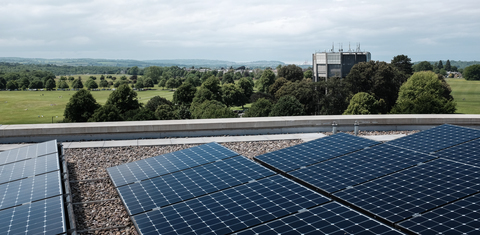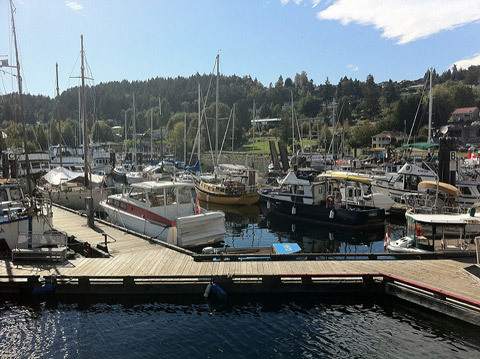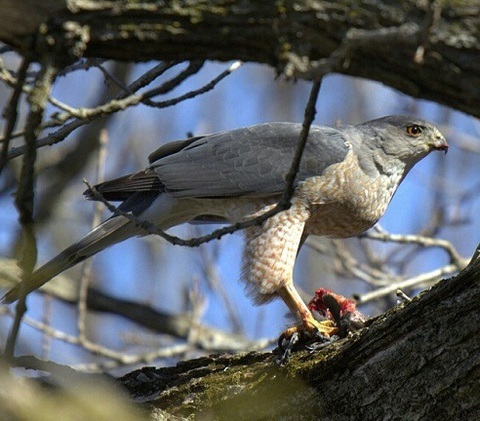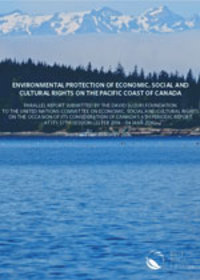David Suzuki's Blog, page 44
February 17, 2016
A Homegrown year in review: 2015
The Homegrown National Park Project had another great year in 2015.
In March, we trained our third troop of keen volunteer Homegrown Park Rangers. Most live along the old Garrison Creek corridor in Toronto's downtown west end but, for the first time, we also recruited from other neighbourhoods, including Willowdale, Junction, Danforth East Village and Dallington -- and Ranger Lori from Brampton!
The fresh recruits hatched new projects and contributed to ongoing events and activities. Highlights include: the award-winning Rain Gardens of East Danforth Village, which transformed ten front yards into bee-friendly gardens designed to absorb excess stormwater; the continuing Community Canoe project, which landed another dozen canoe planters in parks, schools, a church and a café; and the sunny spring Butterfly Block Festival, which drew a crowd of more than 10,000 people for art, bikes, butterflies, wildflowers and a whole lot of milkweed.
Ranger-led projects continued to bring wildflowers and native plants to both private spaces, such as balconies, yards and corporate grounds, and public lands, including Upper Junction, Manitou Park and the West Toronto Railpath.
Rangers guided educational walks on green roofs and through parks and ravines, and hosted community festivals such as the Brampton Block Party and Pollinating Picnic at Little Norway Park. They camped out with twenty families at the second Homegrown Jamboree and finished the season with an epic musical parade through four city parks -- the third annual Homegrown Park Crawl.
Besides plenty of local and international media coverage, in 2015 the Homegrown National Park Project won several awards, including a Vital Innovation Award for the Rain Gardens of East Danforth Village, the 2015 Pollinator Advocacy Award for Canada from the North American Pollinator Protection Council and the Canadian Museum of Nature's 2015 Nature Inspiration Award. Congratulations all around!
The Park Ranger crew will be back for more fun in 2016. Check out davidsuzuki.org/homegrown for this year's events and projects.
Hey! Want more DSF? Join David Suzuki on Facebook

February 16, 2016
B.C. Budget 2016 is a missed opportunity for environmental leadership
The British Columbia government's budget for the fiscal year 2016-17 is out of step with the needs of the province. As the provincial government lauds favourable economic reviews and boasts about strong growth and environmental leadership, it has chosen to cut spending on projects that would reduce carbon emissions, improve public health and bolster economic stability.
The government's plan for 2016-17 calls for reduced spending on already underfunded public transportation infrastructure over the next three years, when the province is expecting rapid population growth. The budget fails to correct the freeze to B.C.'s carbon tax and makes no mention of money to protect B.C.'s coastal or marine resources.
"This budget fails to show leadership in many areas that are important to British Columbians," said David Suzuki Foundation science and policy director Ian Bruce. "Rather than preparing our cities for an influx of residents and moving ahead with responsible actions to tackle climate change, it misses a golden opportunity."
Reduced spending on public transit infrastructure will be particularly damaging to the province's long-term economic prospects. Traffic congestion in Metro Vancouver already costs the regional economy an estimated $1 billion per year in lost productivity, with the figure expected to grow as a million new residents move to the region in the coming decades.
"We had hoped the provincial government would meet the federal government halfway with respect to improving transit infrastructure, but that appears not to be a priority," Bruce said.
"B.C.'s past leadership on climate change has been one of the best economic and environmental success stories in North America," Bruce added. "It's disappointing that a province that once led on climate solutions is in danger of losing its status."
The province still has an opportunity to improve its stance on climate change with updates to its climate action plan expected later this year. With respect to protecting marine and coastal resources, the province needs to do much more to meet conservation targets.
"How the province expects to meet its obligations to British Columbians to look after our coastal waters without mentioning the Marine Planning Partnership in the budget is beyond understanding," said David Suzuki Foundation Western Canada director general Jay Ritchlin. "With the federal government ready to take action on marine protection, it is crucial for the province to engage if we are to take care of the economic driver of coastal B.C. -- a healthy ocean."
In terms of environmental leadership, this budget is a step in the wrong direction.
For more information:
David Suzuki Foundation - Steve Kux 604-374-4102
Hey! Want more DSF? Join David Suzuki on Facebook

Call for action on climate change with a letter to the editor
February 11, 2016
On February 14, rockfish your world with sustainable seafood

(Credit: Gina Collecchia via Flickr)
Love is in the air! Valentine's Day is fast approaching and there are plenty of sustainable seafood options for you to create a delicious and romantic evening.
If you're heading to a restaurant, choose one that includes sustainable seafood menu options. Don't believe everything you're herring... Ask your server about their sustainable seafood choices.
If you salmon the courage to cook for that special someone at home, check out WildSalmonRecipes.com for some easy and tasty recipes. We suggest the baked salmon fillet with crispy herb crust. All recipes on the site -- from some of the West Coast's best chefs -- use wild salmon. Atlantic Canadian farmed salmon remains on SeaChoice's avoid list, so be sure to go wild when it comes to that fish!
Salmon delivers more omega-3 fatty acids than most types of fish, making it a healthy option for you and your solemate.
Choosing seafood options that are healthy for the environment and for your date shows that you love them beyond a shadow of a trout.
Hey! Want more DSF? Join David Suzuki on Facebook

It's time to protect the Great Bear Rainforest's grizzlies

(Credit: Kathryn Burrington via Flickr.)
The agreement between government, industry, First Nations and environmental groups to protect much of the Great Bear Rainforest should be celebrated. The deal makes almost 85 per cent of the forested land base in this massive region on B.C.'s coast off limits to logging. Forestry in the remaining 15 per cent will follow "lighter-touch" practices, called "ecosystem-based management". Most importantly, First Nations will have greater decision-making authority over industrial development on their lands.
However, while the agreement helps protect grizzly bear and other wildlife habitat, it doesn't protect the bears themselves, contrary to B.C. Premier Christy Clark's claims at a news conference. Hunting grizzly and black bears in the Great Bear remains legal.
The agreement actually contains no reference to grizzly hunting. To slow the hunt, First Nations and others must pony up millions of dollars to buy out existing guide outfitting territories open to foreign big-game hunters. Trophy hunting by B.C. residents -- governed under a different process -- will proceed regardless of whether First Nations and their allies purchase and retire foreign hunting quotas.
Had the government been serious about ending the barbaric hunt, it could have banned it outright under the province's Wildlife Act, or simply ended the open season on grizzlies in the Great Bear, as was done by earlier governments to protect the area's Kermode "spirit bears". (Only bears with white fur are protected, even though bears with black coats can carry the spirit bear gene.) Despite the spin, the B.C. government has never recognized the Coastal First Nations ban on trophy hunting in the Great Bear Rainforest.
Seeing grizzlies feeding on salmon as the fish make their way up the coastal streams and rivers of B.C. and Alaska is magnificent. These large brown bears with their characteristic hump and silver-tipped fur scoop salmon from the river in an age-old interplay between ocean, river, fish, bear, bird and forest. The salmon bring nutrients from the ocean. The bears eat salmon and drag the carcasses into the forest, providing food for other animals, like eagles, and fertilizer for the massive rainforest trees.
First Nations-owned and operated bear-viewing operations are booming in the Great Bear Rainforest, creating jobs and revenue. The trophy hunt threatens these sustainable businesses.
The grizzly bear trophy hunt is a sport like dogfighting, cockfighting and bullfighting are sports -- maybe worse. Bears that people come to see and photograph can be legally shot by trophy hunters, armed with high-powered rifles and scopes. That the B.C. government allows it to continue in the face of opposition from First Nations and a huge majority of British Columbians for the sake of profit is disgusting.
I'm not against hunting -- and many who oppose the trophy hunt agree that sustainable hunting can be a good way to put food on the table. But shooting an animal -- often on its way to feed and thus an easy target -- just to hang its head on the wall or put its skin on the floor is not hunting. It's killing for pleasure.
Government justifies allowing this practice by arguing the hunt is well-managed and that grizzlies are plentiful, with only a small number killed each year by hunters. Even if that were true -- which it's not -- it's a poor excuse for an inhumane practice.
Studies confirm earlier research by the David Suzuki Foundation showing the hunt is not sustainable. A peer-reviewed report by Simon Fraser University, University of Victoria and Raincoast Conservation Foundation scientists in the journal PLOS ONE analyzed the provincial government's own data and concluded too many grizzlies are being killed in B.C. They found overkilling of grizzly bears by humans is common and that annual hunting mortality limits set by government are too risky.
Grizzlies reproduce slowly, generally having one or two cubs every three or more years. They also face threats from habitat loss, damage and fragmentation; cascading effects of salmon collapse and climate change; and death from poaching, vehicle and train collisions and the inevitable adverse impacts of careless human behaviour. Grizzlies have already been eliminated or are currently threatened in 18 per cent of the province, including the Lower Mainland and most of the Interior.
It's time to stop killing bears for trophies.
Hey! Want more DSF? Join David Suzuki on Facebook

February 10, 2016
Federal clean tech and municipal funds help environment and economy

(Credit: Matt Gibson via Flickr)
The federal government's latest commitment to provide $2 billion over four years to support the Canadian clean technology sector and invest $31.5 million in municipal environmental projects demonstrates an understanding of three important facts about tackling climate change:
Cities and small-scale renewable energy projects are critical to a larger strategy to drive down emissions and adapt to the impacts of climate change.
Canada's clean tech sector represents not only an incredible opportunity to reduce carbon emissions, it is also the key to building a stable, 21st century economy for Canada and providing good jobs for Canadians that are not won and lost on commodity prices.
Natural assets have clear advantages over those constructed by people. They are cheaper to operate and maintain, provide ecosystem services, do not depreciate and have a carbon advantage. But they are not accounted for in municipal budgets, leaving them prone to deterioration.
With 81 per cent of Canadians now living in urban areas, cities are a key battleground in the fight against climate change. The ways that our urban centres produce and consume energy, the land-use strategies they employ and the manner in which they move people and goods have direct impacts on 40 per cent of national carbon emissions, not to mention the health and quality of life of huge numbers of people. As Canada's largest cities make commitments to cut emissions and increase livability, it is important not to lose sight of the benefits of smaller-scale actions. Investment in small-scale renewable energy projects that provide power for individual communities can collectively reduce emissions while offering energy stability in the face of extreme weather events that can knock out large sections of the power grid. The $31.5-million commitment is a good start, but if we want to move all municipalities in the country forward, much more will be needed.
Municipal governments are also key players in adapting to the impacts of climate change, as they represent the places where most Canadians will experience its effects. Projects like the Municipal Natural Capital Initiative can play a major role in adaptation efforts. The goal of the MNCI is to support municipalities in recognizing, measuring and managing the contribution natural systems make to people and municipal services delivery. Natural capital refers to intact ecosystems that provide services like water capture and filtration, flood control, climate regulation and many others. Identifying these assets and developing policies that give natural capital the same standing as traditional, engineered assets in municipal management can help build resilient communities and reduce spending on projects that would be required to replicate benefits that nature once provided or could provide.
Support for Canada's clean tech sector obviously carries emissions-cutting benefits. It helps with the cost of materials needed to build wind and solar projects across the country and spurs development of new technologies that can improve efficiency of vehicles, buildings and appliances or pull carbon out of the air. However, spending $2 billion to help grow this sector is as much an investment in the economy as it is in the environment. Canada's clean tech sector is one of the fastest-growing parts of the national economy. In 2013 alone, clean tech firms contributed nearly $12 billion to GDP Report Synopsis Final_wcovers.pdf and employed 50,000 Canadians. If this growth continues and Canada achieves only its predicted share of the global clean tech market, the industry will contribute $50 billion to the economy each year and employ 100,000 people by 2022.
Investing in Canada's municipalities and clean tech sector will drive effective climate action, but these announcements must be part of a larger national movement to cut emissions and transition to a clean economy powered by renewable energy. With the prime minister and his team expected to announce a new framework for Canadian climate action in March, we hope national policy will follow the lead of the national pocketbook.
Hey! Want more DSF? Join David Suzuki on Facebook

February 9, 2016
Municipal Natural Capital Initiative - Call for Expressions of Interest

A growing number of municipal governments in Canada are becoming leaders in environmental innovation. One of those innovations involves a natural capital management approach where municipalities are making financial and risk management cases for preserving their natural capital assets. Check out the Expressions of Interest application requirements to find out how you can apply. Letters are due by March 14, 2016. Your municipality could become a leader in natural capital innovation.
Hey! Want more DSF? Join David Suzuki on Facebook

Natural capital innovation at the municipal level

Cities and towns, like Gibsons, B.C., are putting a value on nature and placing it at the heart of their decision-making. (Credit: Bob Cotter via Flickr)
A growing number of municipal governments in Canada are becoming leaders in environmental innovation. One of those innovations involves a natural capital management approach where municipalities are making financial and risk management cases for preserving their natural capital assets. This is how cities and towns, like Gibsons, B.C., are putting a value on nature and placing it at the heart of their decision-making.
The David Suzuki Foundation is part of an alliance that is looking at scaling up the efforts already underway across the country. The project's three-phased approach includes a multi-disciplinary, multi-year initiative to address policy issues, replicate the municipal natural asset approach on pilot sites across Canada and share information.
This work aims to fundamentally transform the protection of natural capital and ecosystem services in Canada's urban areas, with corresponding benefits for habitat, biodiversity, climate change mitigation and adaptation efforts as well as cost-reduction measures.
Does this sound like a good fit for your municipality? Check out the Expressions of Interest application requirements. Letters are due by March 14, 2016. Your municipality could become a leader in natural capital innovation.
Hey! Want more DSF? Join David Suzuki on Facebook

How to be a backyard bird scientist

Meet the Cooper's Hawk. Often an unwelcome guest at backyard bird feeders. (Credit: Theresa Hannah)
Scientists asked themselves, "How can we create a real-time snapshot of bird populations around the world?"
The answer: You and me!
Once upon a time, I birded for a living. But this is great beginner fun. And like any hobby, you'll get better with practice.
Ten reasons not to miss The Great Backyard Bird Count (19th annual) from February 12 to 15, 2016:
It's a great way to help teach kids to count
You only need 15 minutes (but you can do it longer if you want)
It's an opportunity to finally correctly identify that little brown bird
El Nino means you might spot a rare species
It's free
You can try a new DIY project -- a fat block bird feeder (contains nuts)
It's important: Researchers need you and me to help get the "big picture" about bird populations
You can do it anywhere (you don't even need a backyard...)
People around the world are doing it
It'll make you an official citizen scientist. (Warning: it can be highly addictive and you could find yourself swabbing frogs for the chytrid fungus or mapping moth distribution during National Moth Week in July.)
Count birds with me this weekend! Learn how to participate.
Is there a bird you spotted but can't identify? Describe the bird here, including what time of year you saw it, where (city and province), and as many features as possible --size, colours, beak shape, etc. I'll do my best to find an answer.
Sincerely,
Lindsay Coulter, a fellow Queen of Green
Hey! Want more DSF? Join David Suzuki on Facebook

Environmental Protection of Economic, Social and Cultural Rights on the Pacific Coast of Canada

In February 2016, the David Suzuki Foundation made this submission to the Committee on Economic, Social and Cultural Rights. It highlights important aspects of Canada's international human rights obligations relating to the enjoyment of a safe, clean, healthy and sustainable environment. Based on discussions with Pacific coastal communities, this submission sets out Canada's obligations under international human rights law to protect its Pacific coastal ecosystems.
Hey! Want more DSF? Join David Suzuki on Facebook

David Suzuki's Blog
- David Suzuki's profile
- 247 followers





